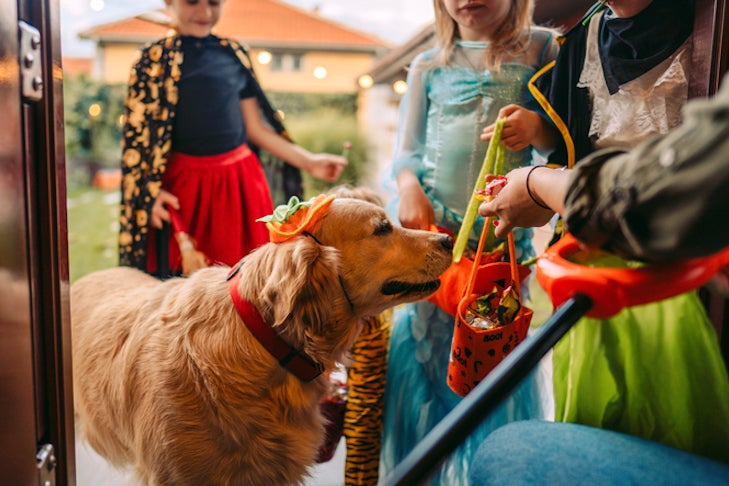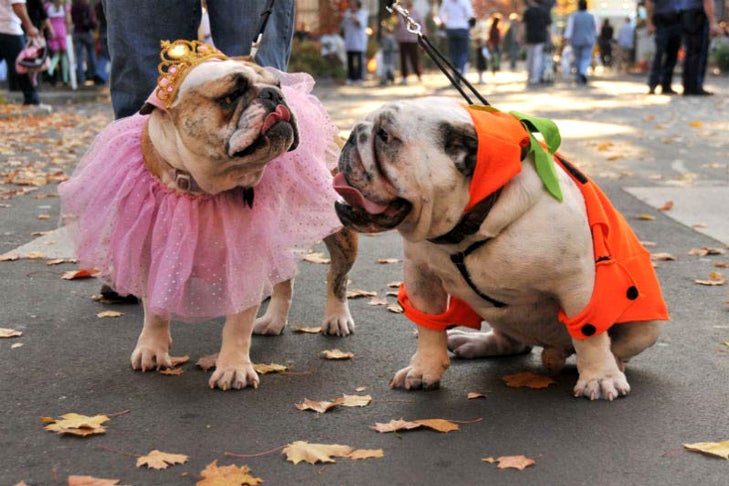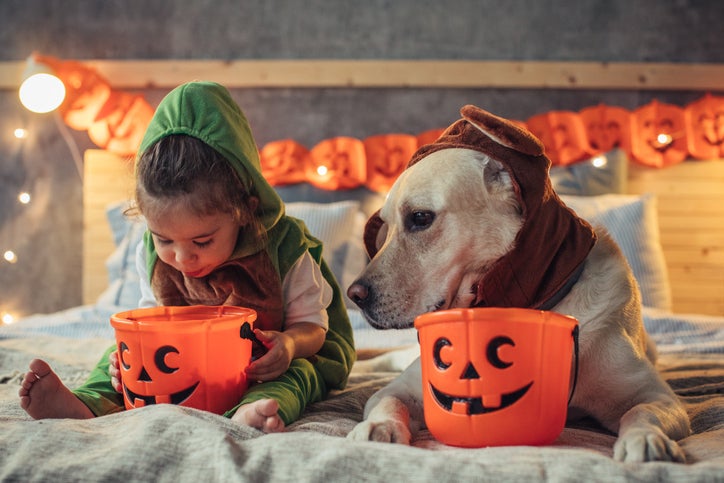Humans in costumes. Dogs in costumes. New decorations around the house. Doorbells ringing throughout the night. Going trick-or-treating. All the tempting smells of Halloween candy.
It’s a lot for a dog to take in. But what do they think of all the rituals and routines of the holiday?
For humans, the spooky atmosphere is what makes this time of year special and fun. But the out-of-the-ordinary rituals of Halloween aren’t always safe, inviting, or exciting for our pets.
Luckily, there are precautions you can take to make your pets feel more comfortable during the festivities and there are easy ways to keep your dogs safe and secure.
Dressing Dogs in Halloween Costumes
Every year, millions of Americans dress their dogs and cats in costumes. That number is expected to reach 29 million in 2019, according to the National Retail Federation. But families with pets at home should be careful when dressing up their dog.
Being paraded around in a costume may be fun for some dogs — but not all, says Dr. Rachel Malamed, a veterinarian and board-certified veterinary behaviorist. “Avoid undue stress and don’t dress your pet unless you are absolutely sure that he/she will be ‘thrilled’ with this idea. Some dogs are fearful of being handled and may also be sensitive to having clothing put on them.”
“Pet costumes can be fun and cute for people, but they can present a danger to pets,” adds Dr. Jerry Klein of the American Kennel Club, who is an emergency and critical care veterinarian. Keep the following in mind if you’re planning on dressing up your dog for Halloween:
- Shop around for a safe outfit: “Fastenings should only be made of Velcro, not buttons, drawstrings, or elastic,” says Dr. Klein. “There should not be any dangling parts that are easily chewed and swallowed by pets. Be sure your pet can breathe easily and move about freely when in its costume.”
- Give your pet a chance to become familiar with their costume over time: Put it on for short periods leading up to Halloween, says Dr. Klein, so that they are accustomed to and comfortable with it.
- Don’t leave your pet unattended in a costume: This is particularly true if costumes have parts that can be easily ingested by curious pets or obstruct your pet’s breathing and movements.

Humans in Halloween Costumes
Getting ourselves dressed up in scary costumes is one of the most fun aspects of Halloween, but bear in mind that it may be scary for dogs to see us that way.
“Many strangers in costume can be extremely scary and stressful for dogs,” cautions Dr. Malamed. “It is best to avoid this type of exposure if you have a fearful animal.”
Even if your pup is usually quite calm, the crowds and unusual attire that they may encounter can still cause them alarm. Because dogs rely on reading human faces and facial expressions to decode our body language, says Dr. Klein, costumes with masks may be the most problematic for pets.
Should You Take Your Dog Trick or Treating?
Owners who want to involve their dogs in their Halloween festivities may wonder whether it’s better to take them out trick-or-treating or stay at home and welcome trick-or-treaters at the door.
“It’s best to keep pets indoors during trick-or-treating hours to prevent them from getting spooked,” says Dr. Klein. “If you do venture out with your dog on Halloween, always keep them on a leash under the control of a responsible adult.”
It’s not unusual for cats and dogs to feel frightened by the doorbell ringing and strangers streaming in and out. And because those people are dressed in costumes, even pets that are not normally fearful of unknown humans visiting may react differently, says Dr. Malamed.
Remember the following to keep your pup calm and safe:
- Make sure your dog is secure to prevent scared pets from running away: Keep them on a leash or away from the door when trick-or-treaters come by, says Dr. Klein.
- Create a structured environment for your pets to celebrate: “If your pet seems comfortable and visitors are willing, you can ask your dog to sit and the visitor can offer a dog treat,” says. Dr. Malamed. “A more structured interaction, such as a command-response-reward format, can make the situation more predictable and positive, as opposed to having people randomly interact by approaching, reaching, or touching your dog. Exposures should be controlled so that they are fun and not forced.”
- Don’t allow neighbors to give your dog human treats: As we’ll go into more detail below, human candy should be off-limits for pets.
- Keep frightened pets in a separate room for their comfort and safety: When dogs are scared, threatened, or territorial, they may be more likely to bite, says Dr. Malamed.

Read the Warning Signs
While the scary side of the holiday may be fun for humans, there’s no reason to produce real fear in our pets. Dr. Malamed suggests families with dog at home be on the lookout for body postures that might indicate fear, including:
- Tail tucking
- The retraction of the ears
- Pacing and restlessness
- Shaking, cowering
- Withdrawal
- Moving in slow motion
- Refusing treats
- Hyper-vigilance
- Yawning
- Lip licking
- Panting
In a moment of fear, dogs may try to escape, so make sure your dog has an ID tag and is microchipped and that the contact information is up to date.

Can Dogs Eat Halloween Candy and Other Treats?
Humans can have a sweet tooth, but what about our pets? Science shows that while dogs may not be big fans of salty foods, they do like sweets. But while we may want to indulge our pets with our favorite candy, not all human foods are safe for dogs to eat. Here are some of the biggest no-nos for pets to avoid:
Chocolate
“Chocolate is probably the most common danger pets encounter on Halloween, so it’s especially important to keep bags of chocolate out of the reach of pets,” says Dr. Klein.
He recommends staying mindful of the following:
- The darker the chocolate, the greater its toxicity level.
- The smaller the dog, the greater the chance for concern.
- If you suspect your pet has consumed chocolate, reach out to your veterinarian, a veterinary emergency center, or a poison control hotline immediately. The sooner you take action, the better the outcomes and the lower the treatment costs. If left untreated, a secondary concern could be severe gastroenteritis or even pancreatitis days later.
- You can help your dog by inducing vomiting to help get the chocolate out of your pet’s system. This can be helpful for up to six hours after the chocolate has been consumed.
- Signs of chocolate poisoning include:
- Hyperactivity (although some dogs may act depressed)
- Drooling
- Nausea, vomiting, and diarrhea
- Tremors and possibly seizures (which can lead to death)
Candy
When families leave candy out in accessible locations, pets may be tempted to help themselves. They may, inadvertently, may consume candy wrappers or the artificial sweetener xylitol, both of which may require you to take your dog to the veterinarian immediately, says Dr. Klein.
Canned pumpkin pie filling
Canned pumpkin can be a healthy source of fiber for dogs. But canned pumpkin pie filling, may contain the above-mentioned artificial sweetener xylitol, which is highly toxic to dogs and can be fatal.
Too many treats
Keeping dog treats on hand is a good idea, but remember these special foods should only make up to 10% of a dog’s diet per day.
Holiday Decorations Are Dangerous Temptations
For curious pups, Halloween decorations can prove to be irresistible, but they are often harmful, so be mindful of what your dog might have access to. Be especially aware of corncobs and pumpkins, which can fragment and block airways or digestive tracts if dogs ingest them. Candles can also cause serious burns to dogs who get too close to them.
The main thing to remember is that Halloween can be more stressful and dangerous for your dog than fun, so keep this in mind when you’re planning your festivities.

